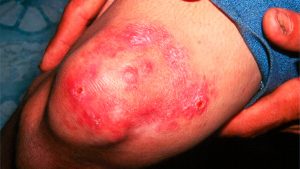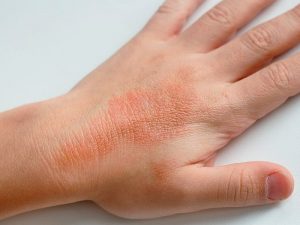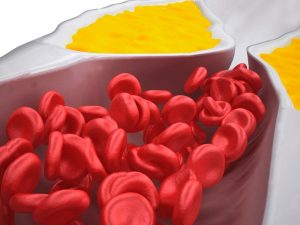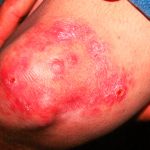Tuberculosis is a disease that mainly affects lungs, although it also can affect brain, kidneys, spine, bladder, joints and others. The Tuberculosis is a bacterial infection that has a prevention system and is curable. The bacterium causing this disease is Mycobacterium tuberculosis. The transmission of bacteria happens through the air, only by people who already suffer from pulmonary tuberculosis by speaking, coughing or sneezing.
If there was an exposition to TB, the person immediately must undergo specific tests for diagnosis, since this disease remains one of the leading death causes in adults worldwide. According to the World Health Organization, 8 million people each year develop active tuberculosis around the world, and 2 million of them die.
The chances of contagion are higher in a weak immune system, which is why the impact is stronger in patients co-infected with HIV. People with celiac disease rash also have more probabilities of tuberculosis contagion due to malabsorption and lack of vitamin D.
Most human infections reach a latent and asymptomatic state in which the bacterium is present but does not cause symptoms or is contagious. Between five and 10 percent of people who do not receive treatment in the latent state evolve to active infection. The symptoms inherent in the bacteria appear, and without treatment, it will infect 10 and 15 more people per year.
Tuberculosis Symptoms
Depending on the place where TB bacteria develop, symptoms vary. The Tuberculosis in its latent state does not present any sign while active pulmonary tuberculosis does. The infection has as general symptoms:
- Tiredness, weakness and fatigue.
- Fever and chills.
- Night Sweats.
- Active pulmonary TB hinders breathing, generates chest pain and bloody expectoration, severe cough for three weeks or more.
- If tuberculosis reaches the joints, there is also a pain similar to that of arthritis.
- When affecting the bladder, there is a pain when urinating in addition to bleeding in the urine.
- TB in the spine causes pain in the back and possible paralysis in legs.
- If it is brain TB, it can cause headaches, nausea and brain damage if not treated in time.
By not treating the infection correctly, tuberculosis can be deadly. Active TB can get in control with medical treatments for extended periods. In its latent state, the patient takes medications that stop the infection to evolve to active.
Tuberculosis diagnosis and tests
An early tuberculosis diagnosis allows the containment of the disease. Beyond preventing the patient from developing the active infection, it is essential to stop the transmission chain. The microbiological diagnosis of TB infection is possible on the direct microscopic examination that would be the PPD tuberculin skin test, and on culture through blood tests. A positive result in a tuberculosis test, skin or blood test, only indicates that the person has the TB bacteria infection, but does not ensure that the person has the latent or active infection. To be sure, the patient undergoes other tests such as chest x-ray, physical exams or sputum sampling.
People who shared time with a person with TB should be tested since they have a higher risk; as well as babies, children and adolescents exposed to adults with a higher risk of contracting the infection. Like those people who come from countries where tuberculosis is common, some of Latin America and the Caribbean countries, Africa, Asia, Eastern Europe and Russia. Those who work in risky environments such as correctional facilities, nursing homes and homeless shelters should also be tested. As well as health workers who care for patients continuously.
If a healthy person becomes infected with TB, it is easy to fight the infection. The bacterium is inactive in the lungs, but if the body cannot resist the infection, especially when the immune system is weak, the bacteria keeps growing, and active TB appears.
Tuberculosis treatment
Tuberculosis without treatment inevitably leads to death. Like all infections, TB is treated with antibiotics. The medications to treat TB will depend on age, the patient overall health and the state of tuberculosis, whether it is latent or active, as well as the resistance of the bacteria to medications. Regularly a treatment for TB extends for six to nine months. Antibiotics are drugs with adverse effects so a specialist should always supervise their use.
The tuberculosis treatment is a combination of drugs, among which are isoniazid, rifampicin, pyrazinamide, ethambutol and streptomycin. By using these drugs, it is always important to follow doctor’s instructions correctly, without omitting doses or interrupting the treatment. The TB medications can damage the liver, so the patient should not drink alcohol or take acetaminophen under TB treatment because they may increase the risk of liver damage.
Timely diagnosis and effective treatment have ensured that 49 million people survived the tuberculosis infection since 2000. Along with the provision of information, supervision and patient support.
Tuberculosis Prevention
The World Health Organization (WHO) recommends vaccinating all newborns that have a higher incidence of infection, those born in higher-risk areas, with Bacillus Calmette-Guerin (BCG), a vaccine against TB disease. The tuberculosis vaccine is systematically included in the children’s calendar. People only need the tuberculosis vaccine once. Children and young people who are going to spend long periods in higher risk regions should receive the vaccine, but not adults. The TB vaccine is not usual in the United States, and it does not always protect people against TB.
When traveling to countries or areas with a high incidence of TB disease, people may not consume any dairy product. And they should take the tuberculin skin test or blood test before leaving the country and repeat between eight and ten weeks after returning.











